
The bounty of the organic gardens at Green Mountain Monastery in Greensboro, Vermont: In 1999, together with Thomas Berry and Sr. Bernadette Bostwick, Sr. Gail Worcelo began Sisters of the Earth Community, the first religious community in the church founded specifically for the healing and protection of Earth and its life systems. (Courtesy of Green Mountain Monastery)

(GSR logo/Toni-Ann Ortiz)
Panelists took time out from enjoying nature and celebrating Earth Day on April 22 to answer this question: How are you and/or members of your community promoting the beauty of creation and the care of our common home?
___
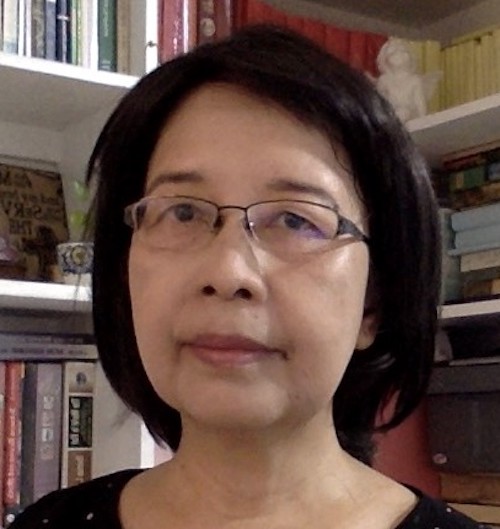 Rosa Ocampo is a Sister for Christian Community from Manila. The five years she spent as a missionary in Peru and El Salvador as well as her apostolate in the Philippine urban slums have provided invaluable insights and experiences that helped shape her views on social justice and the preferential option for the poor. As a journalist, she currently writes for a travel trade publication in Singapore and has written for newspapers and magazines in the Philippines, Hong Kong, Singapore and Saudi Arabia.
Rosa Ocampo is a Sister for Christian Community from Manila. The five years she spent as a missionary in Peru and El Salvador as well as her apostolate in the Philippine urban slums have provided invaluable insights and experiences that helped shape her views on social justice and the preferential option for the poor. As a journalist, she currently writes for a travel trade publication in Singapore and has written for newspapers and magazines in the Philippines, Hong Kong, Singapore and Saudi Arabia.
Sisters for Christian Community Alma Mangao and Ejasmin Lucasan have turned a 1.5-hectare land in San Carlos City, Negros Occidental, Philippines, into a sustainable and productive social enterprise in just over a year.
Alma started Caritas Bliss Eco Farm in January 2020 after years of developing organic farms and livelihoods for grassroots communities throughout the Philippines. Ejasmin joined her in November after months of lockdown in Manila.
Today, the eco farm teems with organic trees, fruits, vegetables and herbal plants known for their medicinal and healing qualities, nourishing the sisters with daily meals while providing a source of livelihood to poor families. Farm produce is sold by rural community mothers, and all profits go to them.
Another wonderful development is the purchase of lagundi leaves by a manufacturer of herbal teas and food supplements. Other products include yellow corn coffee, fermented passionfruit wine, virgin coconut oil, vinegar and fruit juices, thanks to Alma, whose concoctions have won awards for best products and most innovative products in trade fairs.
She and Ejasmin do free tutorials and give away seeds. They also help in the food and school allowances of 50 university scholars of Caritas Manila.
They hope to raise enough funds for a processing facility to augment their product range to encompass organic wellness and body care products, skin care products, food seasonings, and a lot more.
Caritas Bliss Eco Farm also has quiet spots for those who want to pray, meditate, reflect or just relax and unwind in addition to spaces for big gatherings. The sisters see to it that aesthetics are not overlooked in making the gardens conducive to prayer and spiritual retreat, in retaining the view of the stream below, and in using local materials like bamboo and nipa to make the buildings blend with the surroundings.
Lacking a water supply, the eco farm uses solar panels in sourcing the ground water while a tank collects rainwater. Electricity reached the area last December, but the eco farm still uses solar panels to save on cost.
"Recycling" is the operative word, and the use of plastic is prohibited. Trees felled by typhoons become benches. Lumber yard rejects are fashioned into chairs and planters. Old tricycle tires are turned into fences and trellises for climbing plants. Stones from the stream are used for landscaping.
Awed by the fertile land that blesses them with clean food, good health and verdantly beautiful and relaxing surroundings, Alma says: "When we care for our common home, it will also take care of us. When we love the good Earth, it will love us back."
Advertisement
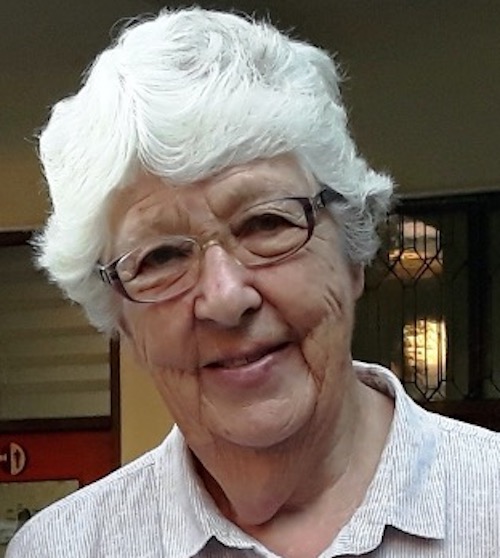 Susan Elizabeth Smith, a Sister of Our Lady of the Missions, has worked in education at various levels: primary and secondary school teaching in New Zealand, university education in New Zealand and Australia, and with Duquesne University in Rome and Manila, Philippines. She has been involved in pastoral and catechetical formation in Papua New Guinea; in adult literacy and numeracy programs for Maori in New Zealand; and in congregational formation programs in Davao City, Philippines, and St. Rambert, France. Currently, she volunteers as a budget adviser, helps with an emergency housing trust and some environmental groups, and writes for publications.
Susan Elizabeth Smith, a Sister of Our Lady of the Missions, has worked in education at various levels: primary and secondary school teaching in New Zealand, university education in New Zealand and Australia, and with Duquesne University in Rome and Manila, Philippines. She has been involved in pastoral and catechetical formation in Papua New Guinea; in adult literacy and numeracy programs for Maori in New Zealand; and in congregational formation programs in Davao City, Philippines, and St. Rambert, France. Currently, she volunteers as a budget adviser, helps with an emergency housing trust and some environmental groups, and writes for publications.
Our congregation is caring for our common home both on the local and congregational levels.
Here in Whangarei, New Zealand, we are working with neighborhood groups to save the rich biodiversity characteristic of New Zealand before the arrival of European settlers in the early 19th century. This is not an easy task: Native flora and fauna are significantly threatened.
Caring for them involves predator and weed control, both of which generate ethical concerns for some. Should we be trapping stoats and opossums? Should we be killing off exotic plants that threaten native trees? Making decisions about environmental issues is not always easy.
After all, in Australia, the opossum is protected. In New Zealand, more than 30,000,000 of these introduced pests are destroying native forests and, in some parts of the country, transmitting tuberculosis to cattle.

The kea is an alpine parrot endemic to New Zealand and considered nationally endangered. It is protected now but used to be killed regularly by ranchers because the bird attacks sheep. This one is pictured on Mount Hutt, Canterbury, New Zealand, August 2007. (Flickr/Bernard Spragg)
One unintended consequence of our involvement with local environmental groups is that we engage with people who usually have no church affiliations or connections, as New Zealand is a very secular country. People like finding out more about Catholic sisters, and on occasion, we can have great theological conversations.
At the congregational level, we have a significant number of tribal sisters living in Myanmar, Bangladesh, India, the Philippines and Kenya. Sadly, 19th-century mission histories show that Western missionaries disregarded the oral traditions of tribal peoples, who tended to convert to Christianity more readily than Hindus or Muslims or Buddhists. That might mean that their oral traditions were more easily forgotten, which is accelerating as more tribal peoples move to cities in search of work and a better life.
However, our sisters are finding that tribal cultures have much to teach us about care of the environment. These traditions look upon planet Earth as their mother, worthy of respect and honor and care. We in the West have looked upon nature as something to be exploited for financial gain. "Sustainability," "care of the environment" and "climate change" are relatively new additions to our vocabulary.
We recognize this as a congregation, and a small group of us is working with younger tribal sisters to collect their stories of creation. These can then become wisdom stories for us as we seek to care more for Mother Earth.
As a Khasi sister from India's northeast, Libera Buhphang, wrote to me in December 2019:
Our Khasi creation stories are not just stories to be told from one generation to the next, but they can serve as a guide in living out our religious vocations, ensuring that we see all of creation as co-creatures with us. As human beings, we cannot live in isolation. We depend on each other and on Mother Earth for our very life and existence. The air that we breathe throughout our lives is freely given. We freely enjoy the cool breeze that gently touches on our faces, the soothing and cool refreshing raindrops on our foreheads, the clean running streams of water, the vastness of mighty oceans, lovely hills — deep valleys and great mountains, the richness of vegetation and variety of fruits and flowers in different seasons. Our tribal stories of creation are significant as we co-create in nurturing life and caring for our environment. Our creation stories invite me, my sisters, and all people of goodwill to rediscover the depths and wisdom found in different tribal creation stories. These are yet another pathway to our Creator God and remind us of our vocation to care for all God's creation.
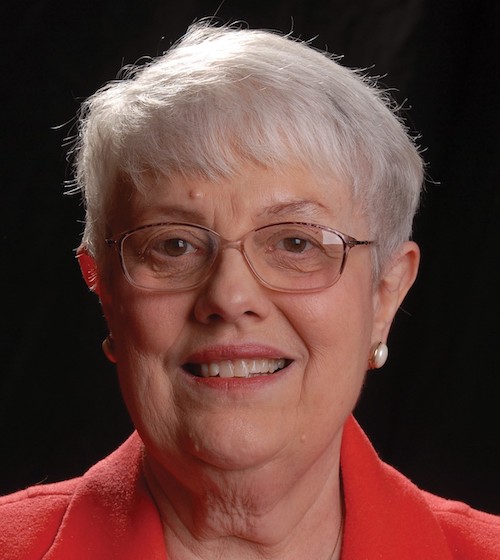 Rita M. Yeasted is a Sister for Christian Community from Pittsburgh, Pennsylvania. After beginning a business career, she entered the Sisters of Divine Providence and became an elementary school teacher. Completing graduate work in English, she began teaching high school and college English. In 1987, she transferred to the Sisters for Christian Community and recently completed two terms as one of their team of international communication coordinators. Presently, she is a distinguished professor of English at La Roche University, her alma mater, and still teaches full-time.
Rita M. Yeasted is a Sister for Christian Community from Pittsburgh, Pennsylvania. After beginning a business career, she entered the Sisters of Divine Providence and became an elementary school teacher. Completing graduate work in English, she began teaching high school and college English. In 1987, she transferred to the Sisters for Christian Community and recently completed two terms as one of their team of international communication coordinators. Presently, she is a distinguished professor of English at La Roche University, her alma mater, and still teaches full-time.

The St. Anthony statue in Sr. Rita Yeasted's garden was transferred from her mother's garden when she died. Yeasted's uncle, Irwin Anthony, had a devotion to this saint and lived with Yeasted, who is "reminded of him in a hundred ways." (Linda Jordan Platt)
"The Lord God planted a garden toward the east, in Eden; and there he placed the man whom he had formed" (Genesis 2:8).
My earliest memory of a real garden was the large vegetable garden planted behind my grandparents' home. There, as a child, I learned the names of all the vegetables, and I can still tell a kohlrabi from a turnip. While my mother planted flowers, as did both my grandmothers, the practicality of growing one's own food impressed me from an early age.
Years passed, and summer flowers grew in small pots in various places I have lived, but when I moved into an old house with a backyard of crabgrass and possibilities, I decided to try my luck.
The previous owners had put a wading pool for their daughters in the center of the yard, and they asked if I wanted it. I surely did not, so they took the plastic pool with them, leaving me with a circular hole, 10 feet across and 6 inches deep. My uncle filled it with composted soil, and I planted not vegetables but spring bulbs, day lilies, and summer annuals around the edges after the bulbs died off.
Eventually, I attempted tomatoes and peppers in pots, two raised beds of beans, peas, carrots, broccoli and lettuce. From summer to fall, I eat vegetables that truly are organic — at least, the ones the deer and rabbits leave me.

Sr. Rita M. Yeasted, a Sister for Christian Community from Pittsburgh, Pennsylvania, works in the raised beds of her vegetable garden. "Gardening helped me to withstand the pandemic. Planting, weeding and harvesting, all within my small space, reminded me — as it does every year— of the cycle of life." (Linda Jordan Platt)
Gardening helped me to withstand the pandemic. Planting, weeding and harvesting, all within my small space, reminded me — as it does every year— of the cycle of life. Gardening, for me, is the handmaid of prayer, with lessons of patience and disappointment. Being close to the earth, feeling the soil in my fingers, connects me with life and God in a different way from teaching.
This Lent, our university chaplain chose the theme of "tending the garden of our soul." The words of John 12:24 — "Unless a grain of wheat falls into the ground and dies, it remains alone" — are played out for me every year. After a hard winter, on the first warm day of February, I purchased a package of anemone bulbs and planted them in my St. Anthony garden. Every day, I look to see if they have broken through the soil. Already, clusters of crocuses and daffodils are blooming in my circular garden amid the mat of dead leaves from my maple tree. As I pull the leaves back, I expose green shoots eager for sunlight.
A gardener's spirituality lasts through every season. We experience death followed by renewal annually. We weed, we water, we bless the earth, and it blesses us in return. Earth is our sacred home. On Ash Wednesday, we are reminded that we came from dust and will return to it. But there is a promised Resurrection, and my garden reminds me of that every spring.

Sr. Rita Yeasted's flower garden — a former wading pool — in Pittsburgh Pennsylvania (Linda Jordan Platt)
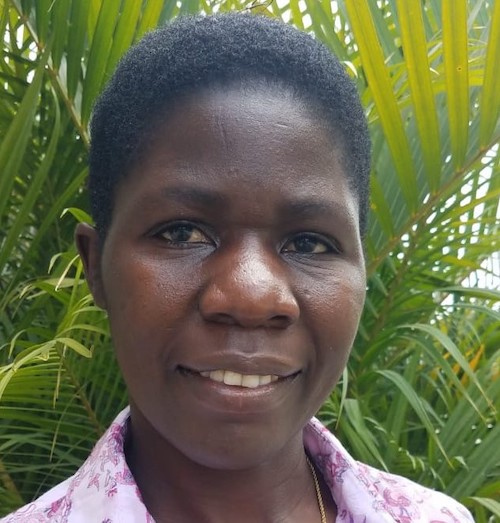 Margaret Grace Nakafu of Uganda is a member of the Medical Missionaries of Mary. With an academic background in sustainable human development as well as HIV counseling and computer science, she has lived and worked in six countries: Uganda, Rwanda, Kenya, Tanzania, Ireland and Honduras. Currently, she ministers in Honduras, doing parish pastoral work, and advocating for youth, vulnerable families and the elderly.
Margaret Grace Nakafu of Uganda is a member of the Medical Missionaries of Mary. With an academic background in sustainable human development as well as HIV counseling and computer science, she has lived and worked in six countries: Uganda, Rwanda, Kenya, Tanzania, Ireland and Honduras. Currently, she ministers in Honduras, doing parish pastoral work, and advocating for youth, vulnerable families and the elderly.
During my school days in Uganda, we carried our lunches wrapped in banana leaves. We reused bottles that originally contained cooking oil to carry our drinking water. In schools where lunch was provided by the school administration, students would bring reusable plates and cups from home. Baskets and bags made of natural materials were used to both carry and store items. These practices, which some might see today as "primitive," give a natural flavor to the food, promote the use of naturally available resources in the cooking and packaging of food, promote the reuse of plastics, and value and preserve natural resources that provide raw materials for handcrafts.
Though even today we still wrap some food in banana leaves for cooking, unfortunately, many of these ecologically sustainable practices are being replaced as we begin to use all sorts of plastics and disposable materials that continue to feed the increasing culture of consumerism.
A story is told of a young man who was walking along the beach when he noticed a boy throwing things into the ocean.
Approaching the boy, he asked: "Young man, what are you doing?"
The boy replied, "Throwing starfish back into the ocean. The surf is up and the tide is going out. If I don't throw them back, they'll die."
The man laughed to himself and said, "Do you realize there are miles of beach and hundreds of starfish? You can't make any difference."
After listening politely, the boy bent down, picked up another starfish and threw it into the surf. Then, smiling at the man, he said: "I made a difference to that one."

A young person plants a pine tree during a reforestation activity that the Medical Missionaries of Mary organized with the youth of Sr. Margaret Nakafu's parish, Nuestra Señora del Carmen in Siguatepeque, Honduras. (Courtesy of Margaret Nakafu)
In his encyclical Laudato Si', Pope Francis calls us to become aware of and dare to turn what is happening to the world into our own personal suffering and, in so doing, discover what each of us can do about it. Like the young boy in the story, we have dared to let the pain of our Mother Earth penetrate our hearts. We know that a one-minute act makes a difference. Sometimes, it is as simple as saying no to a drinking straw in a restaurant. We are creating awareness and reducing the use of one-use materials.
Here in Honduras, we concretely promote the beauty of creation through:
- Adopting the methodology of the five R's: reducing, refusing, reusing, recycling, reforesting;
- In collaboration with our parish and with youth, planting 2,500 pine trees (the national tree of Honduras) in areas where we are assured of their growth;
- Making 150 reusable shopping bags bought by families of our parish; and
- Using our own reusable shopping bags and carrying our drinking water from home.
In these small ways, we are promoting the beauty of creation by making a difference.
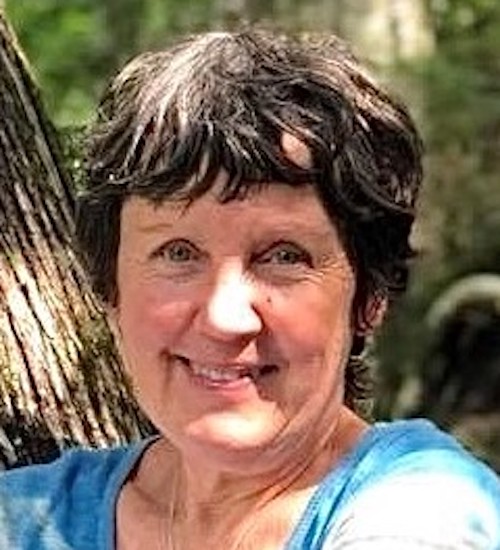 Gail Worcelo is a former Passionist Nun of St. Gabriel's Monastery who served on the leadership team and as novice director. Presently she is the co-founder — along with Sr. Bernadette Bostwick and the late Passionist Fr. Thomas Berry — of an emerging community, the Sisters of the Earth Community at Green Mountain Monastery in northern Vermont. With degrees in Christian spirituality and clinical psychology, she studied liturgical dance and is a choreographer of that style. The founder of Homecomings: Center for Ecology and Contemplation, she travels around the world giving retreats and programs to religious men and women about the Great Work and the Universe Story.
Gail Worcelo is a former Passionist Nun of St. Gabriel's Monastery who served on the leadership team and as novice director. Presently she is the co-founder — along with Sr. Bernadette Bostwick and the late Passionist Fr. Thomas Berry — of an emerging community, the Sisters of the Earth Community at Green Mountain Monastery in northern Vermont. With degrees in Christian spirituality and clinical psychology, she studied liturgical dance and is a choreographer of that style. The founder of Homecomings: Center for Ecology and Contemplation, she travels around the world giving retreats and programs to religious men and women about the Great Work and the Universe Story.
"The time has come when the single greatest service that women religious can make to the larger destinies of the human, the Christian and the Earth Community is the recovery of our intimacy with all those wonderful participants in the communion of life" (Thomas Berry).
In 1994, our mentor and co-founder, Passionist Fr. Thomas Berry delivered a talk to the International Union of Superiors General in Rome. The talk was titled "Women Religious: Voices of Earth."

Sr. Gail Worcelo, Passionist Fr. Thomas Berry and Sr. Bernadette Bostwick began Sisters of the Earth Community in 1999. (Courtesy of Green Mountain Monastery)
He began the talk by saying, "Earth is the lifeboat. If we destroy the boat, all of our ministries and works in the world will go under with it. How can we save the boat and stay afloat?"
Thomas was inviting those congregational leaders 27 years ago into a new moment of grace in religious life, our planetary/cosmological phase.
"If in past centuries, women religious have been dedicated to educating, healing and guiding the human community," he told the women gathered, "the primary role of religious congregations of women at present might well be to preserve Earth from further devastation."
In the same year that Thomas Berry delivered this talk in Rome, I was privileged to read his address beforehand, which was later published in his book The Christian Future and the Fate of Earth.
I had been studying with Thomas Berry since my Passionist novitiate in 1983, and the following words of his address broke my heart open and set my life in a new direction:
What is clear is that no religious community has been founded to protect Earth from further devastation inflicted on the natural world by our human agency. Such would in former times have been unthinkable. Now, however, there is hardly any religious or human activity that has prior claim to our concern because if the lifeboat sinks, everything else becomes irrelevant.
I wonder how those words affected the UISG assembly? For me, they were like a supernova explosion that impacted my entire religious orientation. We must "protect the lifeboat" from further devastation, I reasoned, because if the life systems are not saved, then everything else is irrelevant.
A sculpture of "St. Francis and the Birds" was made by the late artist Frederick Franck in honor of Thomas Berry and looks out from Green Mountain Monastery to the mountains of Greensboro, Vermont. (Courtesy of Green Mountain Monastery)
In 1999, together with Thomas Berry and Sr. Bernadette Bostwick, we began Sisters of the Earth Community, the first religious community in the church founded specifically for the healing and protection of Earth and its life systems.
Our founding preceded Pope Francis' encyclical Laudato Si' by 16 years. In our experience, during that time, there was either indifference or resistance from church leadership who had little awareness of the gravity of our planetary situation, which we likened to "planetary abortion" or the killing of the life systems of the planet.
We also expressed concern for the sacramental life of the church, asking, "How can we baptize babies with toxic water and declare Jesus as the water of life or celebrate Eucharist with chemically laden bread and wine?"
There is no such thing as "human community" without earth, soil, air, water and all living forms. Without these, we do not exist, woven as we are into this larger community, which is the Sacred Earth Community, our lifeboat.







